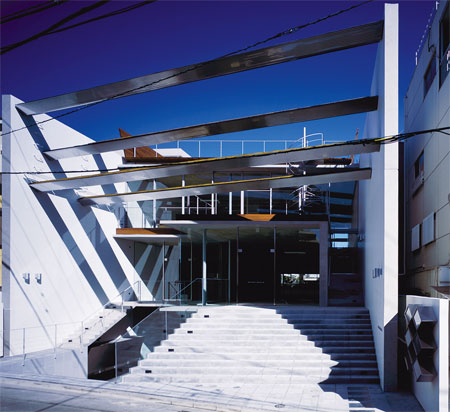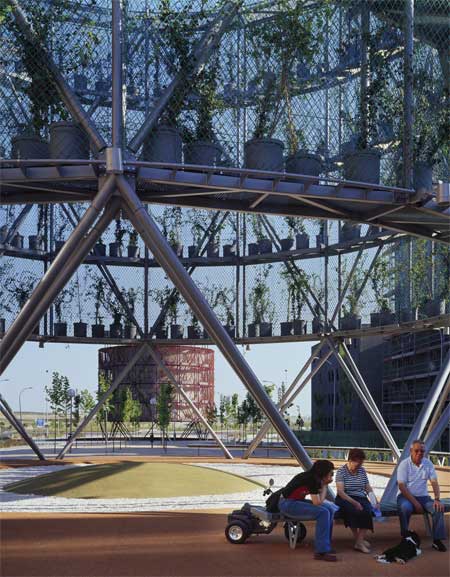
AR Awards for Emerging Architecture - winners
The winners of the Architectural Review's Awards for Emerging Architecture 2007 were announced last night, with three buildings sharing the £15,000 prize money, including Wall House in Chile by Far: Frohn & Rojas (above and below).

See our previous stories for in-depth coverage of this project.

The other two winners were Taketo Shimohigoshi/AAE's vegetation installation at FLEG Daikanyama showroom in Tokyo, Japan (above and below); and Ecosistema Urbano Arquitectos' EcoBoulevard of Vallecas, Madrid, Spain (bottom).

Below: Ecosistema Urbano Arquitectos' EcoBoulevard of Vallecas, Madrid, Spain

Below is a full press release about the awards:
--
AR AWARDS FOR EMERGING ARCHITECTURE:
THREE WINNERS ANNOUNCED
The prestigious Architectural Review Awards for Emerging Architecture 2007 were presented to winning architects and designers from all over the world on 29 November at the RIBA in London. A distinguished international jury assessed hundreds of entries to find three award winners, six high commendations, nine commendations and six honourable mentions.
Now nine years old, the annual AR Awards are recognised as the world’s leading awards programme for young architects, with a mission to discover emerging talent and celebrate the stars of tomorrow. A very wide range of artefacts from 50 countries was presented to the jury. They varied from furniture to landscape projects, and tiny pavilions to dramatic transformations of large existing buildings.
Jury criteria included sensitivity to place and context, awareness of ecological implications, constructional ingenuity, sensitive understanding of materials, and inventiveness in handling space and light. Projects had to demonstrate a clear commitment to improving human life, rather than being preoccupied simply with architecture as art.
The three award winners are:
Taketo Shimohigoshi/AAE for a vegetation installation at FLEG Daikanyama showroom
in Tokyo, Japan. Emblematic of the Awards’ uncanny knack of throwing up the genuinely bizarre, these quirky ‘planted beams’ are a modern take on the hanging gardens of antiquity, re-envisaged for the chaos of Tokyo.
Ecosistema Urbano Arquitectos for the EcoBoulevard of Vallecas, Madrid, Spain.
In its radical vision of ‘air trees’ that temper a hot, arid climate and establish a social focus, Ecosistema’s ‘Eco Boulevard’ in a Madrid suburb is underscored by a strong sense of environmental responsiveness.
Far: Frohn & Rojas for their Wall House in Santiago, Chile. Because of their compact scale and scope for formal invention, houses are a perpetually popular subject of the Awards, and the inventiveness of this Chilean house especially appealed to the judges. Architects Frohn & Rojas experiment with layers of different materials to create an inventive, low budget prototype dwelling.
Award winners share the £15 000 prize money equally.
Highly commended
Six projects were given high commendations. They range from FAM Arquitectura y Urbanismo’s 11 March Memorial in Madrid which speaks eloquently of the need for reconciliation, to a prayer and meditation pavilion in the Sudanese capital Khartoum by Italian architects Studio Tamassociati, which brings people of all faiths closer to a sense of the divine. In West Sussex, Thomas Heatherwick Studio’s East Beach Café on the seafront at Littlehampton manifests a characteristically offbeat approach to form and materials, as did Chris Bosse of PTW Architects’ Watercube, the National Swimming Centre for the 2008 Beijing Olympics. Two Japanese projects were also highly commended - Fuji Kindergarten in Tokyo, by Takaharu and Yui Tezuka Architects with Masahiro Ikeda, which conceives of the roof as a dynamic, inhabitable surface, and the House O in Chiba, by Sou Fujimoto Architects which showed a mature yet lyrical handling of space and light.
Commended
Nine entries were commended. David Jameson’s Eastern Market house renovation in Washington DC elegantly enlivens a conventional terraced house, while Turenscape & Beijing University’s Rice Campus in Shenyang aims to bridge the growing gap between urban and rural life in China. Makoto Takei + Chie Nabeshima/TNA’s Ring House in Karuizawa epitomised the wealth of creativity in Japanese house projects, as did Kamayachi Seiji and Harigai Masafumi’s G House in Yokohama City and Datar’s ‘Ghost’: House in Suginami, Tokyo. In the Bangladeshi capital of Dhaka, Shatotto’s Mizan Residence is a thoughtful study in ecologically conscious, high density living in one of the world’s crowded and most dislocated cities, while in Seoul, the Yeh Gallery by Unsangdong Architects Cooperation epitomises the growing vibrancy of the Korean architectural scene.
J. Mayer H. Architekten’s extension of Danfoss Universe at the Nordborg Science Park in Denmark demonstrated an eye-catching exuberance, while Ryuichi Sasaki + Junpei Kiz + Tetsuo Kobori / Phiframe’s complex for the Ueno Gas Company in Igacity was yet another example of the fertile imagination of young Japanese architects.
Honourable mentions
Six schemes were given honourable mentions and many of these were distinguished by their innovative use of materials. Magma Architecture’s exhibition installation ‘Head In’ for a Berlin art gallery uses tensile fabric to form a sensuously curvaceous interior, while Phooey Architects’ cannabalise old shipping containers to create a childrens’ activity centre in Melbourne. Vo Trong Nghia’s Wind and Water Café in the Vietnamese city of Binh Duong employs traditional bamboo to great effect, while Anagram Architects’ offices in New Delhi are an unusually sculptural essay in brick. The range of projects covered by the Awards, from high culture to urgent social need, is perhaps neatly summed up in OBR Architetti Associati’s Pitagora Museum in Crotone, dedicated to the famous mathematician Pythagoras, and ./studio 3-Institute for Experimental Architecture’s Olifantsvlei Primary School in Johannesburg, a modest but desperately needed pre-school facility for South African township children.
Notes to Editors
Jury members were Shirley Blumberg of Toronto-based Kuwabara Payne McKenna Blumberg Architects; Peter Cook, architect, critic and academic; Peter Davey, former AR editor; Shuhei Endo of Shuhei Endo Architect Institute, Osaka; and Jo Noero from Noero Wolff Architects, Cape Town. AR editor Paul Finch was jury chairman.
All work submitted for the award scheme must be constructed. The age limit of 45 was chosen for entrants because in many countries architects and designers find it difficult to build independently before that age.